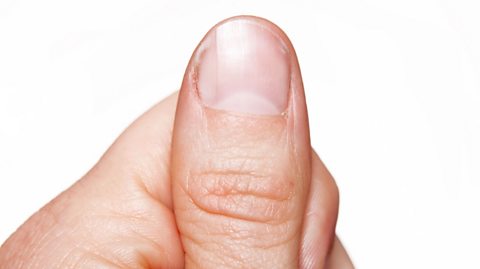Every team has its major names. The poster girls and boys, the faces on the merchandise and the icons of the game, easily recalled by generations of fans.
The human body is a bit like that too. Our hands, feet, noses and knees are those big names; the centre forwards, scrum halves and flyweight champions of the physique world. But then there’s the lesser-known players, the backroom staff and the silent partners who are also essential to keeping a team ticking over. For example, it’s worth keeping your oxter freshly scrubbed, but would you be able to point to it? (In case you can't, it's another name for your armpit).
91Čȱ¬ Bitesize talks you through the names you probably never knew for five parts of the body you see all the time, from your canthus right down to your hallux.
Lunula
Take a look at your fingernail (or your thumbnail). At the base, you may spot a white semicircle, looking a little like the sun peeping over the horizon. That crescent is the lunula.

We don’t all have them (so don’t panic if you don’t!). The Oxford English Dictionary (OED) carries a September 1891 listing from the British Medical Journal which refers to: “A patient… who had a lunula on each thumbnail only.”
Your lunula are not just nail decorations. Doctors can check on their size and colour as an indication of any underlying health issues.
Popliteal fossa
Also known as the popliteal space, this perhaps doesn’t roll off the tongue quite as easily as 'ear', 'nose' or 'armpit' - but on the other hand, you could argue that it’s the armpit of the, well, leg.

The popliteal fossa is the diamond-shaped space you find at the back of your knee, formed between the muscles of the thigh and calf. It’s not just a space created by accident, it allows nerves to pass between the thigh and lower leg.
Canthus
There’s a saying about spotting something from of the corner of your eye. A shorter - but not necessarily snappier - way of saying it is that you’ve spotted something from your canthus.

The points - or corners - where your upper and lower eyelids meet are the canthus. It’s not that new a term, either. The OED contains a 1728 listing from Ephraim Chambers’ Cyclopaedia (a dictionary for the arts and sciences) which reads: “That Corner next the Nose, is called the great, inner, and domestick Canthus.”

Trace a line down the exact centre of your neck, towards your chest, and you’ll come to a small indentation at the bottom, between the two bones known as your clavicles.
That depression has a number of names, including the jugular notch - and also the suprasternal notch.
Hallux
We already have a well-known term for this. In everyday use, we’d call our hallux our big toe.

The word isn’t linked to bigness though. The hallux is the innermost digit of a lower limb. As well as the toes on human beings, it could also refer to the innermost claw on a bird’s foot. In some primates, the hallux is further apart from the rest of the toes, making it easier for these animals to pick up branches, etc, with their feet as the gap gives them greater dexterity.
This article was published in May 2023.
Eight things you use every day but never knew their name
What are the bits on the end of shoelaces called? Or the metal at the top of a pencil?

Five words that have changed their meaning
Why we used to call serious people 'silly' - and other language curiosities.

The big Bitesize spelling and words quiz
Can you wax lexical and get a big score?
